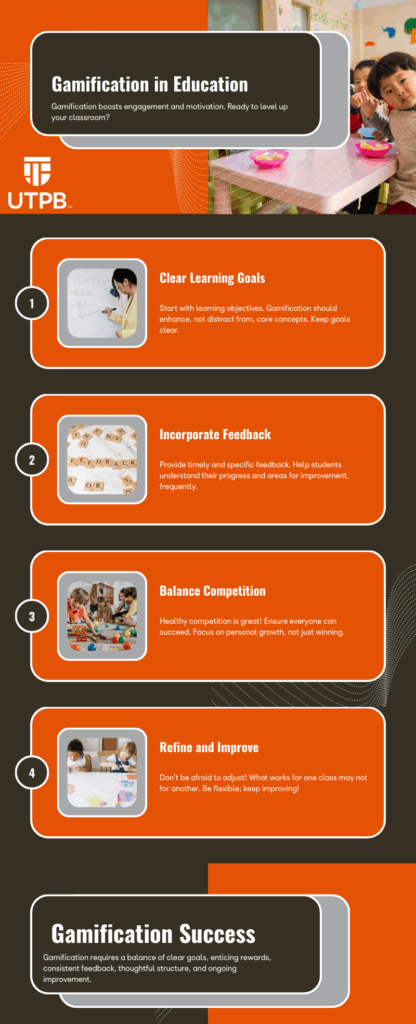Education is changing fast. Today’s classrooms are moving away from rigid, cookie-cutter teaching methods. Alongside more modern teaching approaches like differentiated instruction and project-based learning, another player has entered the chat: gamification.
If the term brings to mind clunky video games on outdated consoles, you’re not alone—and you’re not entirely off base. Today’s students are digital natives, likely playing games on phones and tablets since they could walk. Gamification taps into that digital familiarity, using game-design elements like points, badges, and leaderboards to boost engagement and motivation.
But is gamification right for your classroom or learning environment? Let’s break down how it works, what it offers, and what to watch out for.
What Is Gamification in Education?
Gamification in education refers to integrating game mechanics into the learning environment. By incorporating elements like badges, points, leaderboards, challenges, and progress bars, gamification taps into students’ familiarity with gaming to boost classroom engagement and motivation.
Key Gamification Elements
Here’s a deeper dive into these key components:
- Badges
Students earn badges as they complete tasks, giving them a sense of achievement and progress. For example, a student could earn a “Math Master” badge for mastering a set of problems.
- Points
A simple yet powerful motivator, points can be awarded for participation, completing assignments, or achieving specific milestones.
- Leaderboards
Displaying a class’s progress and ranking allows students to tap into their competitive drive, encouraging them to strive for top positions.
- Challenges
Challenges transform assignments into exciting quests or missions, like turning a research project into a “mystery-solving” adventure.
- Progress Bars
A progress bar can provide a visual representation of a student’s progress, making their achievements clear and motivating them to reach their goals.
These elements of gamification help create an interactive and dynamic learning experience. By tapping into students’ natural desire for achievement and competition, gamification encourages students to stay motivated and accountable.
Benefits of Gamifying the Learning Experience
So, what kinds of improvements can you expect when you bring gamification into the classroom? According to one study, gamification can lead to an 89% increase in student performance. But that’s just the start.
Here are a few more ways gamification can transform learning:
- Boosting motivation
When learning feels like play, students are more likely to show up and give their best effort. Gamification taps into intrinsic and extrinsic motivation by making lessons feel rewarding, encouraging even hesitant learners to give new concepts a try.
- Increasing engagement
Student buy-in is one of the biggest hurdles in education. But when students are motivated, they’re more engaged. Earning points for listening attentively, participating in discussions, or completing worksheets adds layers of interactivity that make the lesson feel less like a chore and more like a challenge.
- Promoting a growth mindset
Many gamified systems allow students to try again when they don’t succeed the first time—just as they would replay a game level. This helps students reframe setbacks as opportunities to learn and improve, reinforcing the message: “I haven’t mastered this yet, but I will.”
- Making progress visible
In traditional classrooms, it’s not always easy for students to track their growth. Gamification tools like progress bars or journey maps let students see what they’ve accomplished and what lies ahead, making progress clearer and goal-setting more intuitive.
Potential Drawbacks of Gamification
While gamification can offer a range of benefits, it’s not without its challenges. Here are a few potential drawbacks to keep in mind:
- Too much focus on external rewards
Visible rewards like points, badges, or class rankings can definitely boost engagement. But if students are motivated by these external incentives alone, their intrinsic (or internal) drive to learn may suffer. If these gamified rewards aren’t used consistently—or aren’t used when students transition to another classroom—some students might struggle to stay motivated or perform at their best.
- Increased pressure and competition
Tools like leaderboards can inspire some students, but they may discourage others. Seeing their name near the bottom of the list, especially in front of peers, can lead to anxiety, embarrassment, or disengagement. Not every student thrives in competitive environments, and some may feel defeated rather than driven.
Examples of Gamification in the Classroom
The type of gamification that works for first graders might not entice, say, 11th graders. Below, we explore some real-world examples of how educators can bring game elements into their classrooms at every level:
- Elementary School
Students earn badges and points for completing reading logs, participating in class discussions, or mastering multiplication tables. A classroom “treasure map” tracks their progress toward a shared goal, like a pizza party or a special theme day.
- Middle School
A science teacher turns a unit on ecosystems into a “mission” game. Students complete challenges (like building a food web) to earn points and unlock new “levels” of the game. Leaderboards encourage friendly competition and collaboration.
- High School
In an English class, students engage in a debate tournament, earning points for preparation, participation, and rebuttals. Badges are awarded for creativity, teamwork, and research skills. A progress bar shows how close each student is to completing a full “debate mastery” achievement.
- College
A business course uses a simulated startup challenge where students work in teams to “launch” a product. Weekly quests include budget planning, marketing pitches, and risk analysis. Points and feedback help students improve, and a final leaderboard highlights top teams based on performance and creativity.
4 Best Practices for Gamification in Education
You don’t have to overhaul your teaching strategy to use gamification in your classroom. In fact, just a few gamified tweaks to your existing lesson plans can make a big difference in student participation and learning outcomes.
Here are a few best practices to get started:
#1 Set Clear Objectives
Make sure students know what they’re working toward. Clear, attainable goals help students stay focused and celebrate milestones, so each step of the learning process feels purposeful.
#2 Design a Simple Points System
Points can be awarded for just about anything, depending on your goals. If classroom management is your focus, dole out points for raising hands, staying on task, or helping others.
If you’re targeting mastery of a specific concept, award points for correct answers, insightful questions, or completing extension activities. The point system should reflect the behaviors and outcomes you want to reinforce.
#3 Use Time Limits
Time limits keep students focused and add urgency. Whether it’s cleaning up or completing an activity, using a visible timer makes it easy for students to see how much time they have left. This works especially well with challenges, encouraging students to work efficiently and stay on task.
#4 Offer Meaningful Rewards
A reward doesn’t always have to be tangible. It could be a new avatar accessory, choosing the next class activity, or unlocking a bonus challenge. Make sure rewards feel exciting and age-appropriate while reinforcing learning goals.
Develop Next-Level Skills with a Graduate Credential from UTPB
Whether you’re ready to bring gamification into your own classroom or you’re working at the district level to boost student engagement, deepening your expertise through advanced education can make a lasting impact. At UT Permian Basin, we offer several education-focused online graduate programs designed to help you meet your career goals:
As a virtual Falcon, you’ll benefit from:
- 100% online coursework.
- Flexible scheduling that fits your busy lifestyle.
- Competitive tuition rates no matter where you’re located.
Take the next step toward becoming a more dynamic, effective educator. Explore your graduate options at UTPB today.
Sources:
https://www.sciencedirect.com/science/article/pii/S1071581920300987
Other articles you may be interested in:
-
Can speaking multiple languages boost your salary? Make travel easier? Even help prevent dementia? The answer is yes. But multilingual societies also face real challenges, from schools struggling with resources to entire languages disappearing. Whether you’re considering learning a second language or wondering how multilingual communities work, this guide covers what you need to know….
-
Bilingualism can come in handy for travel, work, and personal conversations. But did you know bilingual brains function better and longer? Bilingual people: Impressed yet? Let’s explore the cognitive advantages of a bilingual brain. How Does Being Bilingual Benefit Your Brain? Delayed Cognitive Decline People can stay sharp as they age by reading, playing word…
-
“Education is the most powerful weapon which you can use to change the world.” — Nelson Mandela Shaping Education: From Pioneers to Advocates Education has long been a cornerstone of human civilization, shaping the course of society across generations. Educational pioneers like Horace Mann, who championed free public education, and Maria Montessori, who revolutionized individualized learning,…



